This page was published under a previous government and is available for archival and research purposes.
Supply
With a long-term demand forecast in place, Ontario must determine the most effective way to meet that demand so that there is no gap in supply. Ontario needs a balanced, cost-effective supply mix that supports the economy, is modern, can adapt to future changes and provides clean, reliable electricity to Ontario families and businesses for generations to come.
A clean, reliable energy system relies on a balance of resources. Good system planning includes a sustainable supply mix that meets the demands of the public. It also means continually looking for efficiencies and emphasizing the best use of current resources. Ontario’s supply mix includes:
- Conservation: As the best and first resource, it reduces consumption and therefore demand on the system. By avoiding the need to build new generation, all consumers benefit through cost savings.
- Baseload power: Generation sources, such as nuclear and hydro stations, designed to continuously operate (Niagara Falls, for example). Baseload power is the foundation of a stable, secure supply mix.
- Variable or intermittent power: Generation sources that produce power only during certain times such as wind and solar projects. These are important contributors to a cleaner supply mix.
- Intermediate and peak power: Generation sources designed to ramp up and down as demand changes throughout the day such as natural gas and hydro generation with some storage capability. These function as a cushion to the system to ensure reliability when demand is highest.
This supply mix balances reliability, cost and environmental performance.
Figure 3: Forecast supply and demand (2010-2030)
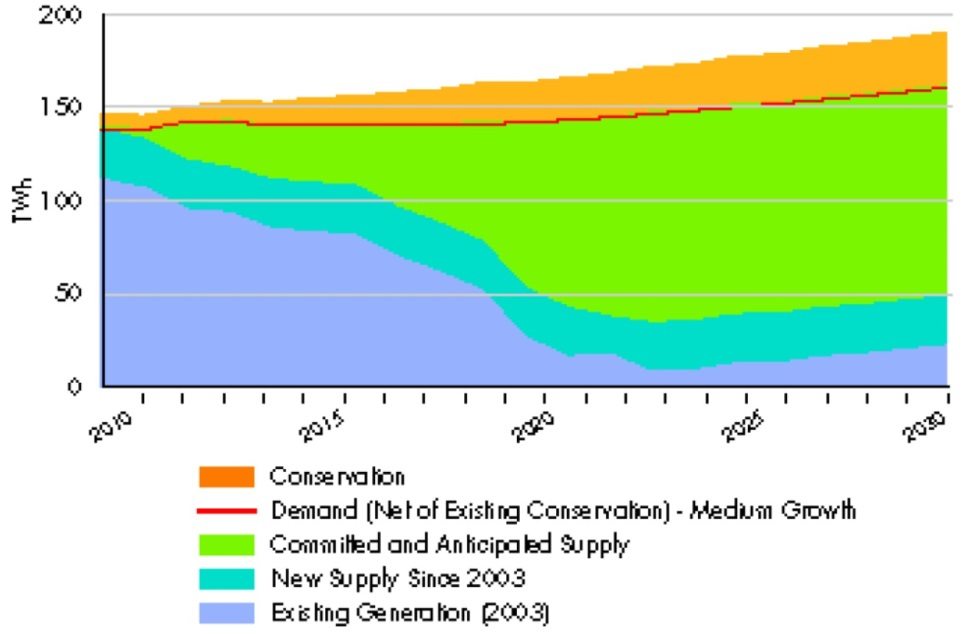
Medium growth-based forecast on conservation, committed and anticipated supply, new supply since 2003, and existing generation prior to 2003. Conservation is approximately 10 TWh in 2010, increasing to 28 TWh in 2030. Supply from generating sources existing prior to 2003 is approximately 105 TWh and decreases to approximately 20 TWh in 2030. New supply since 2003 remains steady at approximately 25 TWh from 2010 to 2030. Committed and anticipated supply begins in 2010 growing to 105 TWh by 2030.
The capacity of the system is necessarily larger than what is actually generated. It is critical to have more capacity than generation to be able to manage normal equipment maintenance and shutdowns, unprecedented peak demands or an unexpected shutdown of an electricity generator. Generation, or the amount of electricity Ontario produces, is measured in terawatt hours (TWh or billion kWh). The capacity of the system, or what it is able to generate, is measured in megawatts (MW).
Figure 4: Contrast between generation and installed capacity
2010 installed capacity (as of October 2010, including conservation)
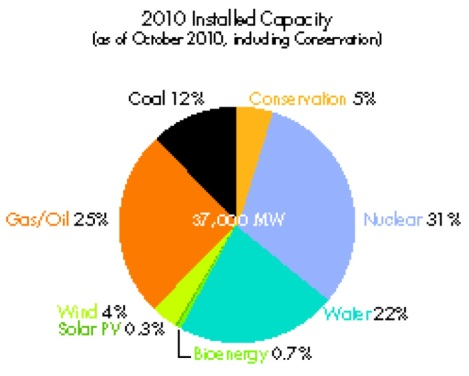
Coal 12%, Conservation 5%, Nuclear 31%, Water 22%, Bioenergy 0.7%, Wind 4%, Solar PV 0.3%, and Gas/Oil 25.
2010 Projected Generation
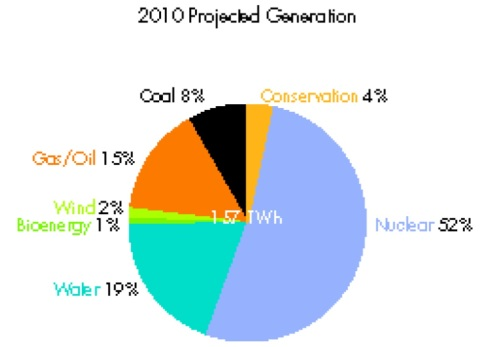
Coal 8%, Conservation 4%, Nuclear 52%, Water 19%, Bioenergy 1%, Wind 2%, and Gas/Oil 15%.
Selecting a supply mix and investment in supply is a matter of choices and trade-offs. A variety of power supply sources - some designed for baseload requirements, some designed for meeting peak requirements - is superior to relying heavily on only one source. For this long-term plan the government has considered environmental, economic, health, social and cost implications to come up with the best possible supply mix.
This improved supply mix will be cleaner, sustainable, modern and reliable. It phases out coal-fired generation at a faster pace, it modernizes Ontario’s nuclear fleet, it includes more renewables, it maximizes hydroelectric power over the near term, and it advances Ontario’s conservation goals.
By 2030, Ontario will have completely eliminated coal as a generation source and will have also increased wind, solar and bioenergy from less than one per cent of generation capacity in 2003 to almost 13 per cent. To ensure reliability, the strategic use of natural gas will be required to complement renewable generation. Nuclear will continue to supply about 50 per cent of Ontario’s electricity needs.
The following chapter will include a review of the various components of Ontario’s electricity supply:
- Coal
- Nuclear
- Renewables: Hydroelectric
- Renewables: Wind, Solar and Bioenergy
- Natural gas
- Combined Heat and Power (CHP)
Figure 5: Building a cleaner electricity system
2003 Generation (TWh)

Coal 25%, Nuclear 42%, Water 24%, Bioenergy 1%, and Gas/Oil 8%.
2010 Projected Generation (TWh)
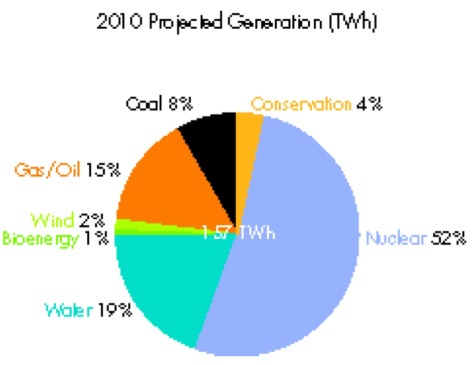
Coal 8%, Conservation 4%, Nuclear 52%, Water 19%, Bioenergy 1%, Wind 2% and Gas/Oil 15%.
2030 Projected Generation (TWh)

Coal 7%, Conservation 14%, Nuclear 46%, Water 20%, Bioenergy 1.3%, Solar PV 1.5%, Wind 10% and Gas 7%.
Coal Free
The Ontario government is committed to improving the health of Ontarians and fighting climate change. Coal-fired plants have been the single largest source of greenhouse gas emissions in the province and among the largest emitters of smog-causing pollutants. Ontario’s reliance on coal-fired generation shot up 127 per cent from 1995-2003, significantly polluting the province’s air.
During that period Ontario also relied on impor ting coal-fired power from the United States. An Ontario study found the health and environmental costs of coal at $3 billion annually ("Cost Benefit Analysis: Replacing Ontario’s Coal-Fired Electricity Generation," April 2005).
Since 2003, the government has reduced the use of dirty coal-fired plants by 70 per cent. Eliminating coal-fired electricity generation will account for the majority of Ontario’s greenhouse gas reduction target by 2014 - the equivalent of taking 7 million cars off the road.
In addition, Ontario Power Generation (OPG) is required to meet strict government- mandated greenhouse gas emission targets, including ensuring that between 2011 and 2014 annual emissions are two-thirds lower than 2003 levels.
Ontario is the only jurisdiction in North America that is phasing out coal-fired generation. The government has committed to eliminating coal-fired generation by 2014 and is introducing clean and reliable sources of energy in its place.
Until then, coal and natural gas plants will continue to provide power in peak- demand periods to maintain the reliability of the system.
Accomplishments
The government of Ontario has shut down eight coal units since 2003 (3,000 MW) and will close the remaining units by 2014 or earlier.
- Lakeview (Mississauga) – four units closed April, 2005
- Nanticoke – two units closed October, 2010
- Lambton – two units closed October, 2010
After the closure of four coal units on October 1, 2010, coal-fired generation makes up only 13 per cent of Ontario’s electricity capacity.
Ontario’s electricity sector emissions will decrease dramatically to only five megatonnes post-2020 as a result of becoming coal-free. Between 2015 and 2019, extensive nuclear refurbishments will take place and Ontario will rely on its natural gas-fired stations to maintain reliable electricity supply.
Figure 6: Reducing emissions in ontario’s electricity sector
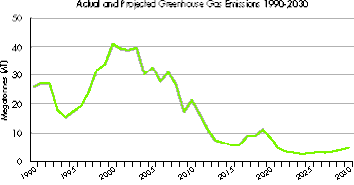
Acutal and projected greenhouse gas emissions 1990-2030 in megatonnes - 26 in 1990, peaking at 41 in 2000, and declining to 5 in 2030
The Plan
Coal-fired plants will cease to burn coal in 2014. Ontario will shut down two additional units at Nanticoke Generating Station before the end of 2011.
The government recognizes the potential benefits of continuing to use Ontario’s existing electricity-generating assets and sites. Coal-fired plants could be converted to use alternative fuels, such as natural gas. Similar to coal, biomass and/or natural gas can provide electricity on demand for peak periods.
In line with the Growth Plan for Northern Ontario and future needs of the Ring of Fire, the province is replacing coal at Atikokan and Thunder Bay and re-powering these facilities with cleaner fuel sources.
Converting the Atikokan Generating Station to biomass by 2013 will create up to 200 construction jobs and help protect jobs at the plant. It will also support jobs in Ontario related to the production of wood pellets and sustain other jobs in the forestry sector. The project is expected to take up to three years to complete. Once converted, the plant is expected to generate 150 million kilowatt-hours of renewable power, enough to power 15,000 homes each year.
At the Thunder Bay Generating Station, two units will be converted to natural gas in a similar timeframe. The Thunder Bay plant is needed not only for local supply to the city of Thunder Bay, but for system reliability in northwestern Ontario, particularly during periods of low hydroelectric generation and until the proposed enhancement to the East-West tie enters operation. The government will work with suppliers on the planning process to convert the Thunder Bay units.
Ontario will continue to explore accelerating the closure of the remaining six units (four at Nanticoke and two at Lambton), taking into consideration the impact of the closures on system reliability.
Ontario will monitor the progress of the continued operation of nuclear units at Pickering. The government expects in 2012 to have an update on the progress of extending the life of these units. At this time, Ontario will consider the possible conversion of some of the units at Nanticoke and Lambton to natural gas, if necessary for system reliability. Due to the lead times involved, planning and approval work for the natural gas pipeline infrastructure required to Nanticoke will begin soon.
Ontario will continue to explore opportunities for co-firing of biomass with natural gas for any units converted to natural gas. Decisions on other biomass opportunities will have to carefully take into account the ability to bring in fuel supply and the cost of conversion.
Nuclear – New/Modernized
Nuclear power is a reliable, safe supplier of the province’s baseload generation needs - accounting for about 36 per cent of the province’s installed electricity capacity. Nuclear operates 24 hours a day, seven days a week and it produces about 50 per cent of the electricity generated in Ontario. Nuclear power does not produce any primary air pollution or release greenhouse gases into the atmosphere.
Nuclear power plants are able to operate steadily, providing a plentiful, consistent supply of energy for decades at stable prices. In addition, the fuel cost for a nuclear power plant is a small portion of its total costs, so nuclear power is generally not impacted by fuel price escalation or fluctuations.
Accomplishments
A number of nuclear power producing units have been modernized and returned to service since 2003 including:
- Pickering A Unit 1, in November 2005, providing 515 MW (or about 6 percent of new supply)
- Bruce Unit 3, in March 2004, providing 770 MW (or about 9 per cent of new supply)
- Bruce Unit 4, in November 2003, providing 770 MW (or about 9 percent of new supply)
Future Needs
Nuclear power is crucial to providing reliable electricity to the province. Units at Bruce B and Darlington are expected to reach the end of their service lives over the next decade. To extend the life of these units, each would have to be shut down for about three years while being modernized.
At the time of the 2007 Plan, there was a need for new nuclear planning to begin immediately. Since then, demand has declined and renewable generation has become a bigger contributor to the system. Investment in renewables, the reduction in demand and the availability of natural gas have all reduced the immediate need for new nuclear. However, to preserve the long-term reliability of the system, particularly for baseload generation, additional investment in nuclear generation will be required.
Ontario will continue to rely on nuclear power – at its current level of contribution to the supply. Nuclear generation is ideally suited for providing baseload generation because of its unique economic and operating characteristics. Nuclear plant operational design and economics depend on the plants being able to operate steadily throughout the year. A generation mix of 50 per cent nuclear combined with baseload hydroelectric generation is sufficient to meet most of Ontario’s baseload requirements.
If nuclear capacity beyond this were added, the hours in the year in which nuclear capability exceeded Ontario demand could substantially increase. Under such surplus conditions, some nuclear units might need to be shut down or operate differently than intended. This could lead to significant system and operating challenges and so therefore, generating too much nuclear is undesirable.
The Plan
Over the first 10 to 15 years of this Plan, 10,000 MW of existing nuclear capacity will be refurbished. Investment should focus first and foremost on the improvement of existing assets so that those facilities can continue to provide reliable, affordable electricity. A coordinated refurbishment schedule was agreed to in 2009 by a working group including OPG, Bruce Power, the OPA and the Ministry of Energy. This schedule will be regularly reviewed and updated to reflect current information on resources and plant performance and conditions.
The government is committed to continuing to use nuclear for about 50 per cent of Ontario’s energy supply - a capacity of 12,000 MW will produce that amount of energy. The remaining nuclear capacity of 10,000 MW at Darlington and Bruce will need to be refurbished and modernized.
The remainder of the nuclear capacity that Ontario will need for its projected demand (about 2,000 MW ) will be made up of new nuclear at Darlington.
The construction of new nuclear infrastructure requires a significant lead time (approximately 8 to 10 years to commercial operation) and while new nuclear supply will be needed in Ontario, it must be provided at a fair price to ratepayers. Both refurbishment and new build will have significant positive impacts on local economies – and considerable employment opportunities.
In February 2008, the government of Ontario launched a process to procure two new units at the Darlington site. Atomic Energy of Canada Limited (AECL) was one of three vendors who met the February 2009 bid submission deadline. AECL emerged as the only compliant bidder in the process; however the AECL bid price exceeded the province’s target. Ontario then sought to finalize a deal with the company to procure the units at an acceptable price.
During the discussions between the Ontario government and the federal government, the federal government announced its intention to sell AECL in May 2009. The news cast a great deal of uncertainty over Ontario’s procurement process. The position of uncertainty that the federal government placed AECL in, together with a much higher than anticipated price, made it very difficult for Ontario to finalize a procurement that was in the best interest of ratepayers. As a result, Ontario suspended the RFP process in June 2009.
The Province continued to engage AECL, as the only compliant bidder, in discussions with the hope that a deal could still be finalized. The talks did not lead to any demonstrable progress. Consequently, the Premier of Ontario wrote to the Prime Minister requesting that the process to sell AECL be halted. It was Ontario’s position that both levels of government should try to complete the procurement with AECL before the company was sold so that Ontario’s need for significant nuclear refurbishment and new nuclear generation could be met while simultaneously protecting jobs and preserving the industry in Canada. This proposal was not pursued by the federal government and their process is continuing without a deal with Ontario being completed.
It is anticipated that the federal government will identify a preferred vendor by the end of this year. Ontario is expecting that the federal government will restructure AECL in a manner that will allow Ontario to be able to complete a deal with the new owner at a price that is in the best interest of ratepayers.
The decrease in demand together with the new supply added in recent years, means that Ontario is well-positioned to examine a number of options for negotiating new nuclear production at the right time and at a cost-effective price.
In the meantime, OPG is continuing with two initiatives that were underway prior to the suspension of the new build procurement process: the environmental assessment and obtaining a site preparation licence at Darlington. It is essential that the province stay ready to construct new nuclear plants as part of the government’s ongoing commitment to modernize Ontario’s nuclear fleet.
OPG will invest $300 million to ensure the continued safe and reliable performance of its Pickering B station for approximately 10 years, to 2020. Following this, OPG will begin the longer term decommissioning process and will work with the community of Pickering and the advisory committee to explore future opportunities for the site.
A 2010 report by the Canadian Manufacturers and Exporters estimates the employment and economic benefits from refurbishing and operating the Bruce and Darlington reactors will be substantial: almost 25,000 jobs and annual economic activity of $5 billion.
In developing a new-build procurement and modernization strategy Ontario will:
- Secure an acceptably priced contract for construction of nuclear new build under specified timeframes.
- Pursue project terms that are in the best interest of ratepayers.
- Retain the maximum number of high-quality, high-paying nuclear industry jobs in the province while providing opportunities for long-term growth of the nuclear industry.
Renewables: Hydroelectric
Ontario has been generating renewable power from water - hydroelectric power - for over 100 years. Hydroelectric power is clean, renewable, cost-effective and helps to contribute to clean air quality. Hydro currently makes up the vast bulk - about 90 per cent - of Ontario’s total renewable energy supply, representing 8,127 MW of capacity. It is a reliable source of electricity that can continue to provide clean energy for generations to come.
Accomplishments
The 2007 Plan projected a total of 7,708 MW of hydroelectric capacity by 2010. The government has exceeded this goal. Ontario has also launched significant hydroelectric projects - the first major investments in 40 years. Since October 2003, 317 MW of new hydro projects have been brought online.
Hydroelectric capacity
Future need
More hydroelectric power will be added to Ontario’s electricity system in the next eight years than over the previous 40 years. Unlike Quebec, Ontario does not have the geography to support massive reliance on hydroelectric power. (Quebec has almost four times the hydro capacity of Ontario.) New hydroelectric generation will continue to be an important part of a clean, reliable system over the next 20 years. The government is also reviewing how crown land is made available for waterpower projects, particularly for smaller Feed-In-Tariff (FIT) Program projects.
The Plan
Ontario will continue to develop the province’s hydroelectric potential and is planning for 9,000 MW of hydroelectric capacity by 2018.
Once the Niagara Tunnel expansion is complete, it will provide enough electricity to power 160,000 homes. When the capacity expansion at Lower Mattagami is complete, the project will provide enough electricity to power over 300,000 homes. These projects will help to maximize Ontario’s existing hydro projects.
Existing hydro is the cheapest form of generation in Ontario and in many cases, it can help to meet peak power demand. There are a number of projects that are currently under consideration, such as:
- Two hydroelectric generating stations on the Little Jackfish River (north of Lake Nipigon) that could add 100 MW of capacity
- New Post Creek, a 25 MW project in the development stage
- Mattagami Lake Dam, a 3-6 MW development at Kenogamissi Falls on the Mattagami River.
Ontario will plan for future hydroelectric development where it is cost-effective to build. This will mean fit-level hydro projects (less than 50 MW) will also be considered.
New hydro projects complement other renewable initiatives and help to eliminate coal by 2014. Some additional projects will be considered, but large-scale projects, usually in remote locations, are not economically feasible at this time due to high capital and construction costs. Transmission, engineering and environmental factors are also challenges. However, due the importance of hydroelectric generation, Ontario will continue to study Northern hydro options over the period of the Plan.
Renewables: Wind, Solar and Bio-energy
Ontario has become a North American leader in producing energy from sources that are continually renewed by nature such as wind, sun and bioenergy. Renewables do not produce harmful emissions, which contribute to smog, pollution and climate change. Increasing Ontario’s renewable energy supply helps reduce the province’s reliance on fossil fuels. Greater investments and reliance on renewable energy help to ensure that Ontario has a clean and reliable electricity system for generations to come.
Accomplishments
Ontario is now Canada’s leading province for wind and solar capacity and home to the country’s four largest wind and solar farms. The world’s largest photovoltaic solar farm is in Sarnia (Enbridge’s 80 MW Sarnia Solar) and Canada’s largest wind farm is near Shelburne (the 199.5 MW Melancthon EcoPower Centre). In 2003, Ontario had 10 wind turbines; today, the Province has more than 700.
Since October 2003, the government has signed more than 16,000 renewable energy supply contracts from wind, water, solar and bio-energy sources. This includes almost 2,400 MW of small and large renewable power projects under North America’s first comprehensive Feed-in Tariff (FIT) Program, introduced in 2009. These fit contracts represent a private sector investment of $9 billion and are projected to create approximately 20,000 direct and indirect clean energy jobs.
The success of the fit Program has also attracted the notice of global investors, including a consortium of companies led by Samsung C&T Corporation, laying the foundation for Ontario to become a global clean energy production and manufacturing hub.
Some 51 community projects will provide renewable electricity supply to the grid through the Ontario fit program. From these projects, more than 200 MW of clean electricity will be generated by communities engaging in, solar, wind and bio-energy projects across Ontario.
Thousands of Ontarians are also participating in the microfit Program. Homeowners, farmers or small business owners, are able to develop a very small or "micro" renewable electricity generation project (10 kilowatts or less in size) on their properties. Under the microfit program, they are paid a guaranteed price for all the electricity they produce for 20 years.
Figure 9: Progress on 50,000 projected green energy act jobs

10,000 jobs in 2010, 32,000 in 2011 and 51,000 in 2012.
Major Private-Sector Renewable Investments in Ontario
The $7-billion Green Energy Investment Agreement with Samsung C&T Corporation and Korea Electric Power Corporation (Consortium), is the single largest investment in renewable energy in provincial history. It will:
- Build 2,500 MW of wind and solar power.
- Deliver an estimated 110 million megawatt-hours of emissions-free electricity over the 25-year lifetime of the project - enough to supply every Ontario home for nearly three years.
- Create more than 16,000 new clean energy jobs to supply, build, install and oerate the renewable generation projects.
- Lay the groundwork with major partners to attract four manufacturing plants.
Out of the 16,000 new clean energy jobs, this investment is expected to create or sustain 1,440 manufacturing and related jobs, building wind and solar technology for use in Ontario and export across North America.
As part of the Green Energy Investment Agreement, Samsung and Siemens have announced plans to build Ontario’s first wind turbine blade manufacturing plant, which will create up to 900 direct and indirect jobs. The Consortium will negotiate with manufacturing partners to locate three other plants in Ontario for wind turbine towers, solar inverters and solar module assembly.
Under the agreement, three of the four manufacturing facilities are scheduled to be ready in 2013, while the fourth is scheduled to be in operation by the end of 2015. The Consortium also intends to use Ontario-made steel and other Ontario content in its renewable energy projects for items such as wind turbine towers.
More than 20 companies have publicly announced plans to participate in Ontario’s clean energy economy, in the last year. These companies are currently operating or plan to set up solar and wind manufacturing facilities in Ontario in the following categories: solar PV modules, mounting systems, inverters, wind turbine blades and wind turbine towers. Some recent examples include:
- Heliene Inc., producing modules in Sault Ste. Marie;
- Canadian Solar, will manufacture modules in Guelph;
- Photowatt, producing modules in Cambridge;
- Samco, an auto parts manufacturer now also producing solar mounting systems in Scarborough;
- Schletter, producing solar mounting systems in Windsor;
- Sustainable Energy Technologies partnering with Melitron to produce inverters in Guelph;
- Satcon, producing inverters in Burlington;
- Siemens will be producing wind turbine blades; and,
- DMI Industries is producing wind turbine towers in Fort Erie.
Future Needs
Ontario will continue to be a leader in renewable energy development and generation. The growth of the renewable energy sector will be influenced by electricity demand, the ability of the system to accommodate additions to the grid, continued innovation in the renewable technology sector and global demand for renewable energy production. Expansions and upgrades to the transmission and distribution system will be necessary to increase the capacity for renewable energy in Ontario.
As more and more of Ontario’s electricity comes from renewable energy sources and research and innovation of Smart Grid technologies continues, there will be increased opportunities for renewable energy projects, both large and small to be established in Ontario.
There will also be greater opportunity for employment in this field. Renewable energy projects require skilled labour, such as engineers as well as construction and maintenance labour across the province. As renewable energy projects are established, the need for skilled and general labour will continue to provide jobs for thousands of Ontarians over the next decade. Innovation in new technology also contributes high skilled jobs and economic opportunities for Ontario.
The Plan
Ontario will continue to develop its renewable energy potential over the next decade. Based on the medium growth electricity demand outlook, a forecast of 10,700 MW of renewable capacity (wind, solar, and bioenergy) as part the supply mix by 2018 is anticipated. This forecast is based on planned transmission expansion, overall demand for electricity and the ability to integrate renewables into the system. This target will be equivalent to meeting the annual electricity requirements of two million homes.
The province’s renewable energy capacity target will be met with the development of renewable energy projects from wind, solar, biogas, landfill gas and biomass projects across Ontario.
Future rounds of fit projects will be connected to the Bruce to Milton transmission line and the priority transmission projects identified as part of this Long-Term Energy Plan. This will enable 4,000 MW of new renewable energy projects to be connected.
In the near term, the OPA will be releasing information regarding the status of all fit applications not offered contracts as of June 4, 2010. These applications will be subject to the first Economic Connection Test (ECT) under the fit program. The ECT process, to be conducted on a regular basis and in alignment with major planning or system development milestones, will help to determine whether the costs of grid upgrades to allow a fit project to connect to the grid are economically viable.
For the period after 2018, depending on changes in demand, Ontario will look for opportunities to increase the development of renewable energy projects and expand renewable energy capacity in the Province. Ontario will review the electricity demand outlook in the next Long-Term Energy Plan to explore whether a higher renewables capacity forecast is required.
Fit contract prices were set following extensive consultations and are designed to ensure a reasonable rate of return for investors while providing good value for clean, renewable energy for Ontario ratepayers.
As part of the scheduled two-year review of the fit Program in 2011, the fit price of renewables in Ontario will be re-examined. Successful and sustainable fit programs in a number of international jurisdictions (such as Germany, France and Denmark) have decreased price incentives. Advances in technology and economies of scale reduce the cost of production. A new price schedule will be carefully developed to achieve a balance between the interests of ratepayer and the encouragement of investment in new clean energy in Ontario.
The response to the microfit and fit programs has been a tremendous. Thousands of Ontarians are participating in the program to feed clean energy into the grid.
Given the popularity of Ontario’s growing clean energy economy, applications to the microfit and Capacity Allocation Exempt (CAE fit ) program are outpacing needed upgrades to the grid. To continue to ensure the growth of small clean energy projects, Ontario will continue to invest in upgrades to the transmission and distribution systems to accommodate renewable supply.
In areas where there are technical challenges, the OPA, Hydro One and Local Distribution Companies will continue to work with proponents that have already applied to the CAE fit or microfit program.
Natural Gas
Natural gas plants have the flexibility to respond well to changes in demand, making them an important cushion for Ontario’s electricity system - particularly for peak periods.
Natural gas produces electricity either by burning to directly power a gas turbine or by producing steam to drive a steam turbine. A combined cycle gas plant combines these two technologies. Natural gas can supplement baseload power supply and, because it responds quickly to increases in demand, it can also complement the intermittent nature of wind and solar electricity generation.
Natural gas is much cleaner than coal. Some air emissions - particularly mercury and sulphur dioxide - are totally eliminated when natural gas replaces coal. Carbon dioxide emissions are reduced by between 40 and 60 per cent. Currently, Ontario’s electricity generation capacity from natural gas is over 9,500 MW.
By replacing coal with natural gas and renewable energy sources, Ontario has greatly reduced greenhouse gas emissions from its electricity supply mix. This policy has prepared Ontario for the possibility of greenhouse gas regulation in the North American market.
Accomplishments
The Ontario government and the OPA have launched a number of clean natural gas and cogeneration projects since 2003 to help with local reliability and peak demand.
The 2007 Plan projected that some 12,000 MW of natural gas would be needed by 2015. Since then, changes in demand and supply - including about 8,400 MW of new, cleaner power across the system and successful conservation efforts - means that less capacity will be required.
Future Needs
In 2009, about 10 per cent of Ontario’s electricity generation came from natural gas. In the coming years, the government anticipates that it will be necessary to maintain the amount of natural gas supply at its current level in the supply mix.
The Plan
Natural gas will continue to play a strategic role in Ontario’s supply mix as it helps to:
- Support the intermittent supply from renewables like wind and solar
- Meet local and system reliability requirements
- Ensure adequate capacity is available as nuclear plants are being modernized
The 2007 Plan outlined a forecast need for an additional three gas plants in the Province, including one in the Kitchener-Waterloo-Cambridge and one in the southwest GTA.
Because of changes in demand along with the addition of approximately 8,400 MW of new supply since 2003, the outlook has changed and two of the three plants - including the proposed plant in Oakville - are no longer required. However, a transmission solution to maintain reliable supply in the southwest GTA will be required.
As indicated in 2007 Plan, the procurement of a peaking natural gas-fired plant in the Kitchener-Waterloo-Cambridge area is still necessary. In that region, demand is growing at more than twice the provincial rate.
Ontario is taking advantage of its existing assets with the conversion of two coal- fired units in Thunder Bay to natural gas. (See page on Coal.)
Over the next few years, non-utility generation contracts, which were entered into between the private sector and the former Ontario Hydro in the early 1990s, will begin to expire. Many of these are natural gas-fired. These non-utility generators - or NUGs as they are known - have been part of Ontario’s overall supply mix for 20 years. They can contribute up to 1,550 MW of clean power to the system. The contracts with NUGs are currently held by the Ontario Electricity Financial Corporation, an agency of the Ministry of Finance.
As non-utility generator contracts expire, the IESO and the OPA will determine if the generation is still required to help ensure reliability. The government will direct the OPA to design contracts that will encourage NUGs to operate during periods when it would most benefit the electricity system. The OPA will be authorized to enter into new contracts where this generation is needed and will negotiate to get the best value for consumers.
CHP (Combined Heat and Power/Cogeneration)
Combined Heat and Power is the simultaneous production of electricity and heat using a single fuel such as natural gas. The heat produced from the electricity generation process is captured and used to produce steam or hot water that can then be used for industrial and commercial heating or cooling purposes, such as district energy systems.
CHP can make more efficient use of fuel and therefore reduce greenhouse gas emissions. CHP overall efficiency can exceed 80 per cent - which means that 80 per cent of the energy can be captured as electricity or usable heat.
Accomplishments
Currently, the total industrial CHP capacity in Ontario is estimated to be about 2,000 MW, or about 6 per cent of Ontario’s installed generation capacity.
In October 2006, the OPA awarded seven contracts with a total capacity of 414 MW - enough to provide the power for 400,000 Ontario homes. Much of this new capacity (395 MW ) will be coming from industrial projects. These facilities are in communities across the province including: Windsor, Kingsville, London, Oshawa, Markham, Sault Ste. Marie and Thorold.
The Plan
Ontario will target a total of 1,000 MW of CHP. It will be procured through the OPA and will include existing contracts, individual negotiations for large projects and a new standard offer program for smaller projects in key strategic locations.
The government will encourage new local CHP generation projects, where price, size and location make sense. The government will work with the OPA to develop options for small, targeted programs. Over the next 20 years, Ontario will see more community-scale CHP projects. The OPA will create a new standard offer program for CHP projects under 20 MW in specific locations.
The OPA will continue to negotiate larger CHP projects on an individual basis. For example, the OPA and St. Marys Paper Corporation recently signed a 10-year contract for the company to generate clean electricity at a new 30 MW biomass- fuelled plant to be built next to St. Marys existing mill in Sault Ste. Marie. The plan is expected to reach commercial operation by early 2014 and will support 550 direct and indirect jobs.